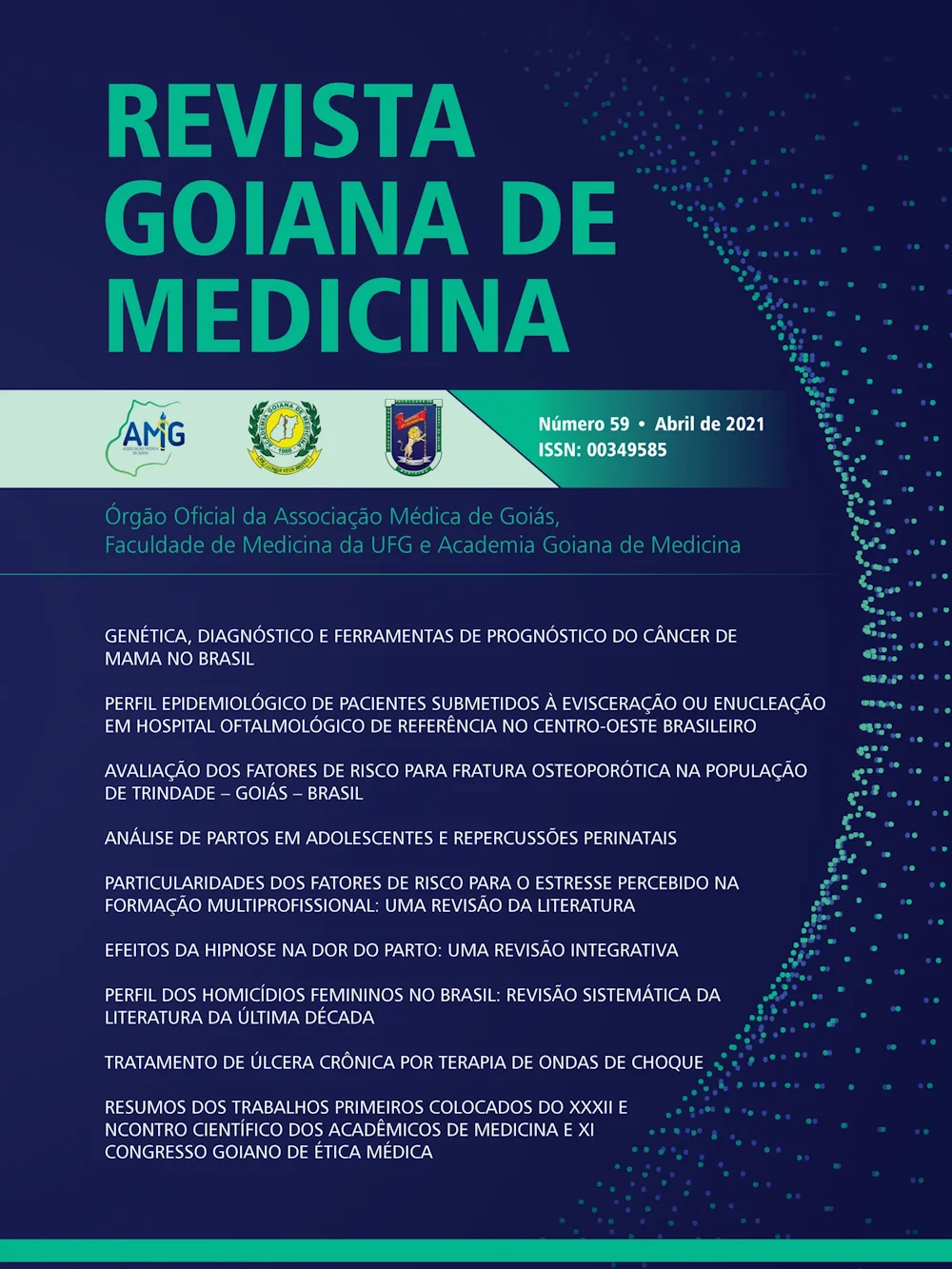Perfil epidemiológico de pacientes submetidos à evisceração ou enucleação em hospital oftalmológico de referência no Centro-Oeste Brasileiro
Palavras-chave:
OFTALMOLOGIA, EVISCERAÇÃO DO OLHO, ENUCLEAÇÃO OCULAR, EPIDEMIOLOGIA, SAÚDE PÚBLICAResumo
Objetivo: descrever a prevalência e o perfil epidemiológico dos pacientes submetidos à evisceração e enucleação no Hospital Fundação Banco de Olhos de Goiás, referência em oftalmologia no Sistema Único de Saúde para o Centro-Oeste brasileiro. Métodos: estudo observacional retrospectivo e descritivo realizado a partir de prontuários de pacientes atendidos entre janeiro de 2013 e dezembro de 2018. As variáveis estudadas foram:tipo de cirurgia,sexo, idade,indicação cirúrgica enúmero de cirurgias por ano. Resultados: Foram analisados 227 prontuários, dos quais 181 (79,74%) eram de pacientes submetidos à evisceração e 46 (20,26%) à enucleação. De toda a população, 71,81% (163) era do sexo masculino e 28,19% (64) do feminino, com média de idade de 57 anos, sendo mais elevada no grupo da enucleação. Ambos os procedimentos estudados tiveram o trauma como principal indicação (63,00%), seguido de endoftalmite (14,54%), olho cego doloroso (11,89%), phthisis bulbi(9,25%) e, por fim, neoplasias malignas (1,32%). Dos anos avaliados, notou-se um aumento substancial do número de eviscerações realizadas e uma pequena variação da quantidade de enucleações. Conclusão:Reforça-se a necessidade do uso óculos de proteção e outras medidas de segurança no trabalho, do diagnóstico e tratamento precoce da endoftalmite, do glaucoma e das neoplasias malignas com intuito de reduzir a estatística da evisceração/ enucleação e seus respectivos impactos.
Referências
Grumann Júnior A, Adam Neto A, Lima GC, Vergini F, Souza TAB. Estudo de melanoma da coróide no Hospital Regional de São José - Santa Catarina. Arq Bras Oftalmol. 2006;69(4):551-5.
Cruz AAV, Baccega A, Akaishi PMS, Castro FAA, Alencar VM, Hoyama E, Paula S, Chahud F. Órbita. In: Vital Filho J, Cruz AAV, Schellini SA, Matayoshi S, Figueiredo ARP, Herzog Neto G. Série Oftalmologia Brasileira - CBO (Órbita, Sistema Lacrimal e Oculoplástica). 3 ed. Rio de Janeiro: Cultura Médica. 2013:3-81.
Nunery WR, Timoney PJ, Ng JD, Sokol JA, Hetzler KJ. Enucleação e evisceração. In: Spaeth GL, Danesh-Meyer HV, Goldberg I, Kampik A. Cirurgia Oftalmológica - Princípios e Prática. 4 ed. Rio de Janeiro: Elsevier. 2012:441-9.
Odugbo OP; Wade PD; Samuel OJ; Mpyet CD. Indications for destructive eye surgeries among adults in a tertiary eye care center in North Central Nigeria. J West Afr Coll Surg. 2015;5(2):135-53.
Musa KO, Aribaba OT, Onakoya AO, Rotimi-Samuel A, Akinsola FB. Indications for destructive eye surgeries at a Nigerian tertiary eye care centre: A ten-year review. Niger Postgrad Med J. 2016;23:12-6.
Koylu MT, Gokce G, Uysal Y, Ceylan OM, Akıncıoglu D, Gunal A. Indications for eye removal surgeries. A 15-year experience at a tertiary military hospital. Saudi Med J. 2015;36(10):1205-9.
Al-Dahmash SA, Bakry SS, Almadhi NH, Alashgar LM. Indications for enucleation and evisceration in a tertiary eye hospital in Riyadh over a 10-year period. Ann Saudi Med. 2017;37(4):313-6.
Chan SWS, Khattak S, Yücel N, Gupta N, Yücel YH. A decade of surgical eye removals in Ontario: a clinical-pathological study. Can J Ophthalmol. 2017;52(5):486-93.
Roelofs KA, Aghazadeh H, Cheema M, Weis E, Badilla J. Enucleation and evisceration: an analysis of indications, histopathological findings, and surgical trends over 23 years at a tertiary care hospital in western Canada. Can J Ophthalmol. 2019;54(1):106-10.
Shah RD, Singa RM, Aakalu VK, Setabutr P. Evisceration and enucleation: a national survey of practice patterns in the United States. Ophthalmic Surg Lasers Imaging. 2012;43(5):425-30.
Etebu E, Adio A. Indications for removal of the eye at a tertiary hospital in south-southern Nigeria. East Afr J Ophthal. 2013;14:19-22.
Shah-Desai S, Tyers A, Manners R. Painful blind eye: efficacy of enucleation and evisceration in resolving ocular pain. Br J Ophthalmol. 2000;84:437-8.
Rasmussen ML, Prause JU, Johnson M, Kamper-Jorgensen F, Toft PB. Review of 345 eye amputations carried out in the period 1996–2003, at Rigshospitalet, Denmark. Acta ophthalmol. 2010;88(2):218-21.
Keenan TDL, Sargent NJ. Enucleation and evisceration in the Palestinian territories. Middle East Afr J of Ophthalmol. 2011;18:170-2.
Kagmeni G, Noche CD, Nguefack-Tsague G, Wiedemann P. Indications for surgical removal of the eye in rural areas in Cameroon. Ophthalmol Eye Dis. 2014;6:27-30.
Geirsdottir A, Agnarsson BA, Helgadottir G, Sigurdsson H. Enucleation in Iceland 1992–2004: study in a defined population. Acta ophthalmol. 2014;92(2):121-5.
Vittorino M1, Serrano F, Suárez F. Enucleation and evisceration: 370 cases review. Results and complications] Arch Soc Esp Oftalmol. 2007;82(8):495-9.
Ababneh OH, AboTaleb EA, Abu Ameerh MA, Yousef YA. Enucleation and evisceration at a tertiary care hospital in a developing country. BMC Ophthalmol. 2015;15:120.
Rasmussen ML. The eye amputated - consequences of eye amputation with emphasis on clinical aspects, phantom eye syndrome and quality of life. Acta Ophthalmol. 2010;88(2):1-26.
Park YG, Paik JS, Yang SW. The results of evisceration with primary porous implant placement in patients with endophthalmitis. Korean J Ophthalmol. 2010;24:279-83.
Hui JI. Outcomes of orbital implants after evisceration and enucleation in patients with endophthalmitis. Curr Opin Ophthalmol. 2010;21:375-9.
Grossniklaus HE, Brown HH, Glasgow BJ, Murray TG, Shetlar DJ, Wilson DJ. Ophthalmic pathology and intraocular tumours. In: Liesegang TJ, Skuta GL, Cantar LB, editors. Basic and Clinical Science Course. San Francisco: American Academy of Ophthalmology. 2004:28.
Elbakary MA. Four petals evisceration for atrophia bulbi. Middle East Afr J Ophthalmol. 2015;22(2):226-9.
Yousuf SJ, Jones LS, Kidwell ED., Jr Enucleation and evisceration: 20 years of experience. Orbit. 2012;31:211-5.


